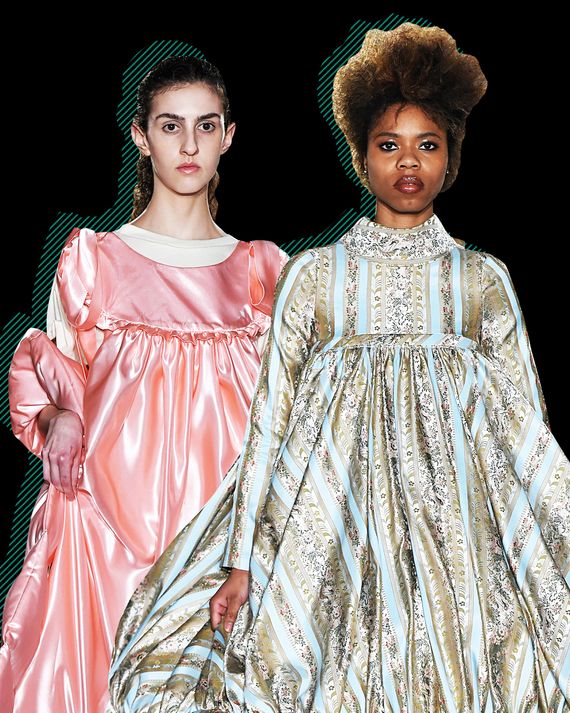
Adventures in history have long motivated fashion designers, like artists and playwrights, but the difference between inspiration and mere reference is whether the trip says something about the present. On Tuesday, Laura Kim and Fernando Garcia of Oscar de la Renta took their audience to the crossroads of Islamic and Christian culture, in Andalusia; Gabriela Hearst visited the early Soviet winters of the dancer and choreographer Maya Plisetskaya; and the young designers at Vaquera plundered some fancy 18th and 19th-century wardrobes.
And who went to the front of the class? Patric DiCaprio, Claire Sully, and Bryn Taubensee of Vaquera.
Their idea, according to the opaque show notes, was the charmed life inside a spectacular New York City apartment circa 1927. The setting at the Ukrainian National Home gave no hint of this, yet it was obvious from the clothes that the designers had been looking at historical costumes and interiors — a mid-19th-century cage crinoline, pantaloons, Regency stripes, rich brocades, pink dressing gown worthy of Manet, and detachable men’s shirt collars.
Nothing was ever too literal, though. The use of historical modes brought to mind John Galliano’s early work — that is, before Dior and Givenchy — but it was done with more raw wit and far less emotional attachment to those styles or periods. Watching the models clomp or bolt down the leaf-strewn runway, you could easily imagine them heading out the door in a crinoline dress or a Dutch-collared shirt with a sturdy corduroy skirt into the slush of Second Avenue.
I had the feeling that Taubensee, Sully, and DiCaprio were mainly attracted to the forms — a mountainous dressing gown, the stiffness of a masculine collar, the goofy bounce of a crinoline — and then figured out how the lifestyle and manners associated with those outmoded shapes related, perhaps, to their own style. The designers play a lot with proportions (usually oversize) and there’s more than a hint that they’re pricking capitalist culture, with their allusions to wealth and bigwig trappings. There’s also a boffo child’s play quality to their shapes and color; again, Galliano once did the same for his own label — to the befuddlement of many. But Sully, DiCaprio and Taubensee know how to keep things grounded without losing their sense of freedom. They make the best oversize, schlump-y pants around (shown with a tiny sweatshirt), and their Regency-striped shirting looked both cool and well-made.
As for those stiff men’s collars, the sort that maybe your great-grandpa wore, they were treated as a Surrealist prop: instead of going around the neck, they were stuck, arrow-straight, at one side, an emblem of disorder or, perhaps, a younger generation’s fantasy of an unraveling patriarchy.
During a preview of their collection, Kim and Garcia explained that they visited Dubai and Abu Dhabi last fall, mainly to see clients, and then Barcelona, and that the mixture of Islamic and Christian culture inspired them, mainly in prints, embroidery, and colors. Alex Bolen, who is chief executive of Oscar de la Renta and the founder’s son-in-law, added that de la Renta made frequent trips to Spain and once designed a garden based on those at the Alhambra. “He always said that al-Andalus was the apotheosis of civilization,” Bolen said.
De la Renta was no tourist. He was a cultivated man, with a big sense of curiosity, and historical elements came as naturally to him as glamour. With Kim and Garcia, the embrace of foreign influences feels a bit at arms-length. Still, in their favor, they are adept at unpacking de la Renta’s sensibility and taking from it the things that they need — feminized men’s fabrics, for instance, and knitwear with nicely done decorative details like fringe and embroidery — while inviting younger customers to the brand.
The best elements in this strong show were sharp trousers with fresh-looking cropped jackets (we’ve seen a lot of relaxed suits this week, so it was nice to see something different), sleeveless wool dresses with a moderately bell-shaped skirt, romantic blouses (a particular strength of Kim’s) with embroidered skirts, and silk prints inspired by both carpets and needlepoint designs. The evening looks were strictly modern, and favored bustier dresses, spare columns with minimal embroidery, and the odd feathery dream number.
“She was a woman of style, resourceful in a scarce environment,” Hearst said in her show notes of Plisetskaya. That may explain the sensible, almost austere look of Hearst’s urban-meets-country wardrobe of slim military-style coats in with custom-made coin buttons, a long black quilted vest over a leather midi-skirt, and a lovely gray plush coat that resembled fur but wasn’t. The show was strong on rustic hand knits, and a very pretty (and rather offbeat) smocked long-sleeve shirt with a long tiered skirt in ivory gauze cashmere.







